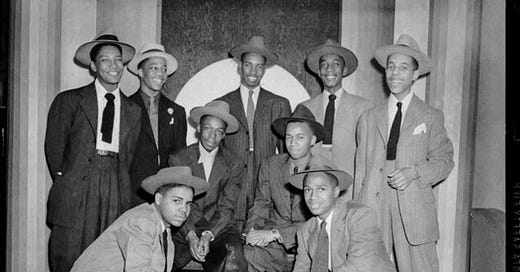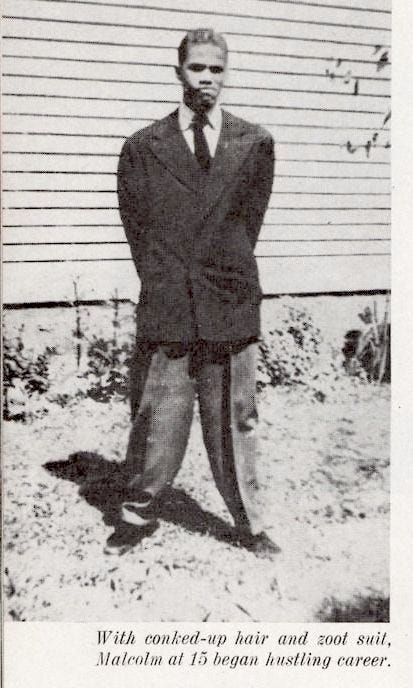The Zoot Suit & A Drink To Match
A jazz outfit that started a race riot and became illegal. With a cocktail at the end to digest the history, with more history.
The Zoot Suit is an outfit that was derived from Harlem and contributed to Jazz and became a symbol of freedom and self expression, until the military and government stepped in...
First I think I need to introduce the musical genre before I introduce the suit and what it meant. To talk about jazz is such a deep topic that I wouldn’t know where to start, probably at the beginning but that is also another story of brass bands jamming through the streets of New Orleans. If we go even further back, Jazz began in what was called Congo Square in New Orleans. From 1724 Catholicism was imposed on slaves alongside the implementation of the Code Noir and the Church forbade farm work on Sundays.
So on Sundays the so called Congo Square became a gathering place for slaves from diverse countries, multi-racial people, Choctaw, Houma, and Chikasaw American Indians. It was a place for expression, dance, music, and to discuss survival strategies. This square formed a new identity in New Orleans. After the Haitian revolution in 1804, large numbers of people arrived from the Caribbean which brought a vast influence towards local arts and introduced Afro-Cuban sounds and new musical instruments. The bamboula, a dance accompanied by drums whereafter blues and jazz (from the French verb “jaser” which means to chat or gossip), emerged. Which in turn created the beginnings of Jazz.

Fast forward to the early blues and then to 1890 where there was a genre that started as Ragtime which evolved to Folk Blues & Classic Jazz (1900’s), Hot & Chicago Style Jazz (1920’s), Swing (1930’s) and finally towards the Bebop or Bop (1940’s) and kept on evolving to this day. We’ll stay in the era of the 1940’s where the zoot suit was born.
The zoot suit was popularised through Jazz, television and later even cartoons, it was a high waisted, baggy legged, tight-ankle, pegged trousers with a long coat to match. The evolution of the style (I believe) started with the Edwardian dandy and then was modernised to the English drape (popularised by the Duke of Windsor, Edward VIII) and finally America transformed the drape silhouette into the zoot suit.
Exactly where and how the zoot suit was created is contested between being born in Harlem, or a custom made order from a tailor shop from a busboy named Clyde Duncan in Georgia or the Chicago tailor and big band leader Harold C. Fox who claims to be the inventor of the suit and who was “laid to rest in a lavender zoot suit” according to Downbeat Magazine’s obituary. Some say it was inspired from Clark Gable’s outfit in Gone With The Wind, and has been attributed to many such as a Memphis tailor, Harold C. Fox the Chicago clothier and a Detroit retailer.

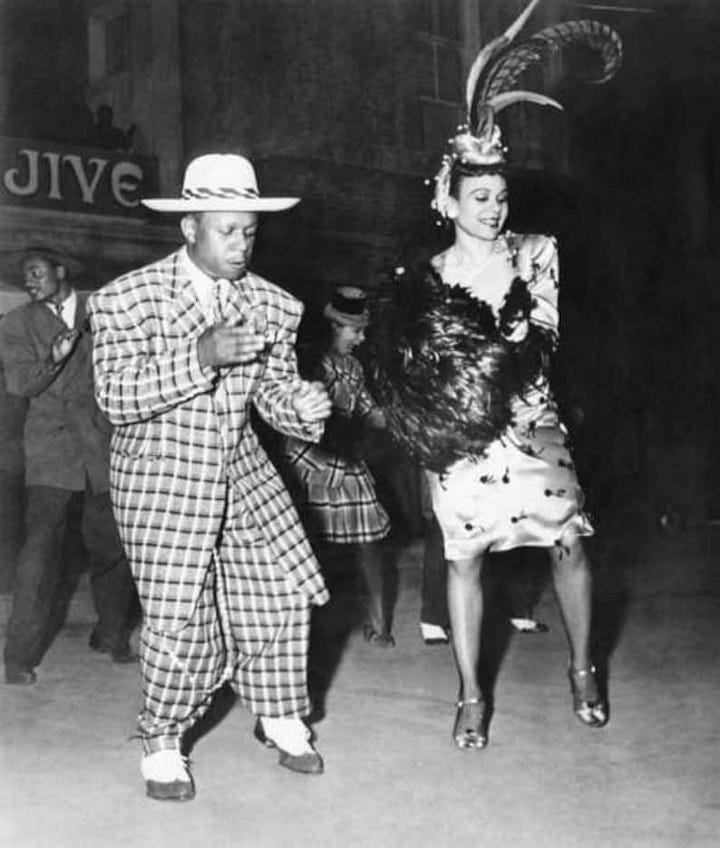

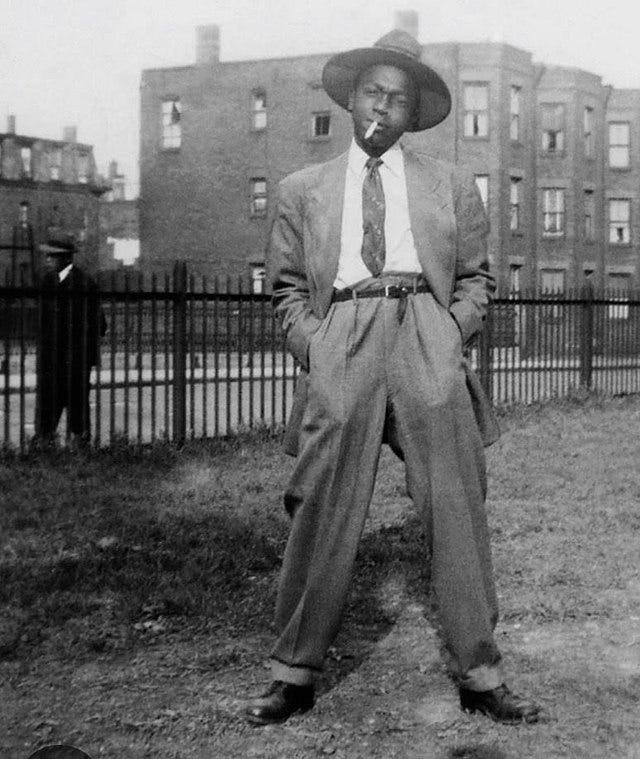
Notable figures and artist like Louis Armstrong, Duke Ellington, Thelonius Monk, Cab Calloway, Lionel Hampton, Count Basie wore zoot suits and helped popularise them. Along with Cesar Chavez and Malcolm X who wore them and later on became political activists. Malcolm X describes it as:
"A killer-diller coat with a drape shape, reet pleats, and shoulders padded like a lunatic's cell".
It was fitting to add a pork pie hat or a fedora and a short fat tie that stopped before the belt buckle, if your suit had thick pin stripes, you were doing something right. Some suits didn’t shy away from having a strong display of colors and patterns. It was a symbol for the 1940 Hipster and Pachuco which was the parallel culture for American Latins, in turn it created a dialect known as Caló — where for the Hipster, it was Jive.
To show how far reaching Jive slang or Pachuco Caló was in 1930-40’s to reach so far as to the 1990’s. Here is a quote from the hit Hip-Hop track by Kid Frost - La Raza :
“ The form I'm speaking is known as Calo. Why sabes que loco? Yo soy muy malo”
This song was one of the first successful Latin hip hop songs. Kid Frost gives a shout out to the rich culture of the past. The zoot suit is still memorialised today in Chicano culture and worn for special occasions.
The zoot suit was a form of identification predominantly among Mexican-Americans, Latins and African-Americans and later with Italian-Americans, Filipino-Americans and the forgotten stories of Japanese-Americans who wore the suits and kept them on in American concentration camps.
First it was supposedly associated with the populace of Harlem, Chicago and Detroit. After-all, jazz had a very far outreach which swept the United States like a storm. The culture of jazz from its slang, clothes and way of sound was a fundamental change in America where it created plenty of pocket communities that identified with what it symbolised and stood for: freedom, self-expression and a sort of rebelliousness.
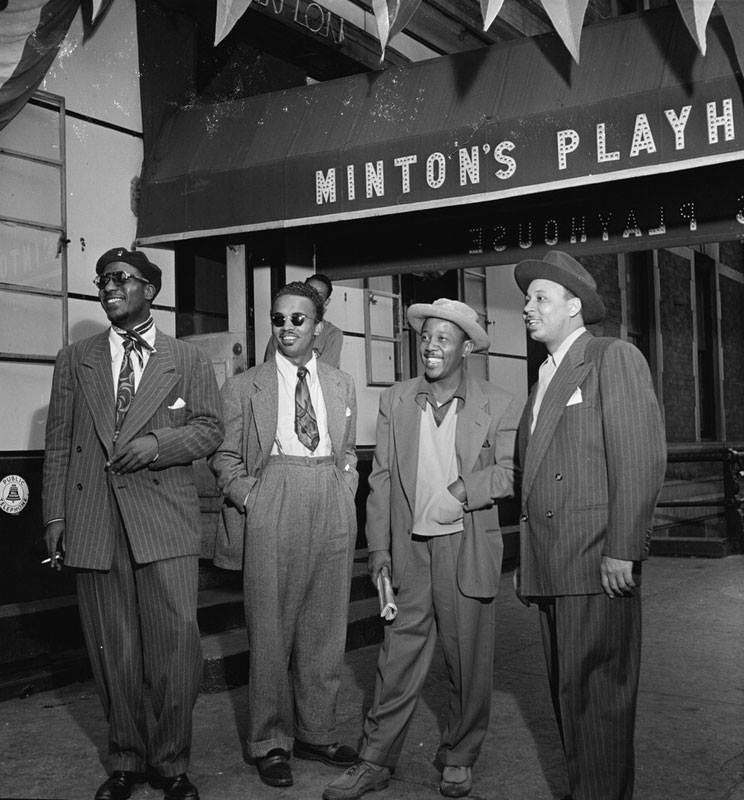
There was a major hiccup for the zoot suit when in March 1942 the United States War Production Board deemed the suit as a waste of material and regulated the production of them. At the time there were attempts to ration food and fabrics to aid in the war. Slowly, and sadly this was an excuse for hostility.
The demand didn’t decline and plenty of people who wore zoot suits were attacked for being “unpatriotic” all across America because the suit demanded an excess of fabric. Plenty of soldiers, marines and sailors travelled to be stationed to Los Angeles for the war effort. While some of them were given leave while awaiting to be sent out to the Pacific to continue with the war, they noticed the zoot suits. Those on leave felt as if the Los Angeleno youth were abusing the rationing of material with the suits. During that time a mounting unrest suffocated the streets of Los Angeles.
Several altercations across California ensued but in the city of Los Angeles, on June 3rd 1943 arguments rose between sailors and Mexican-Americans in zoot suits, a fight ensued and the LAPD got involved. The police tried to figure out who started what and both parties blamed the other. On the next day a massive group of sailors in the hundreds made their way into East Los Angeles, as soon as the sailors spotted young adults wearing zoot suits they assaulted them with clubs. They stripped everyone wearing the suits of their clothes and burned them in piles. Media coverage spread quicker than the pile of clothes on fire and spurred on more people to join the riots. During the next few days mayhem ensued with mobs of soldiers, sailors, and civilians and they went ahead and beat up everyone wearing a zoot suit. During the days of the riot, not one soldier was arrested for the beatings but police arrested more than 500 Mexican Americans and more than 150 people were injured.
The riots ended June 8th 1943, with the Navy and Marine command staffs declaring Los Angeles off-limits to all military personnel. They stated their men were acting in self-defense. The Los Angeles City Council proposed to criminalise the wearing of zoot suits and after an ordinance was past it was illegal to wear one in Los Angeles for good. The Mexican Embassy gave the State Department a formal protest, which turned into an investigation to figure out the cause of the riots. It was concluded that the root of it was racism, which L.A. Mayor Fletcher Bowron downplayed and blamed it on Mexican youth gangs… The First Lady Eleanor Roosevelt had her own newspaper column where she commented :
“The question goes deeper than just suits. It is a racial protest. I have been worried for a long time about the Mexican racial situation. It is a problem with roots going a long way back, and we do not always face these problems as we should.”
The next day outrage was expressed by The Los Angeles Times accusing her of having communist views.
The suit that started with Jazz and defined an era which was popularised by Pachucos and Pachucas turned into an iconic statement and identity. There was also an aligned style with the french version called Zazou in Paris where Christian Dior declared it:
Hats were far too large, skirts far too short, jackets far too long, shoes far too heavy... I have no doubt that this zazou style originated in a desire to defy the forces of occupation and the austerity of Vichy. For lack of other materials, feathers and veils, promoted to the dignity of flags, floated through Paris like revolutionary banners. But as a fashion I found it repellent.
The symbol of the zoot suit became a source of cultural pride. The riots themselves and the suits inspired plenty of authors and political activists. The inspiration of the suit and the resistance towards authority birthed and inspired plenty of political activists and authors such as Luis Valdez, Ralph Ellison, and Richard Wright.
After all this long winded chronicle, all I wanted to look for was a staple meal from that era, or a cocktail. Which I think a cocktail from a Jazz bar menu would be fitting with this fascinating yet racist moment in history. Now I’m finding myself looking how to get my hands on a pair of zoot suit trousers as an act of solidarity and to commemorate those who stood up against the inequality of the past and the abuse from so called authority that punished people involved in expressing themselves and their culture with the minor means available to them. I give a profound respect to the black and latin community from back then, and now, and all the others that hopped on the zoot suit hype, because it stood for something beautiful. From the political activists, to the authors and musicians, actors and singers, the average citizen and even to the little kids trying to emulate something they might not have really understood and just wanted to fit in.
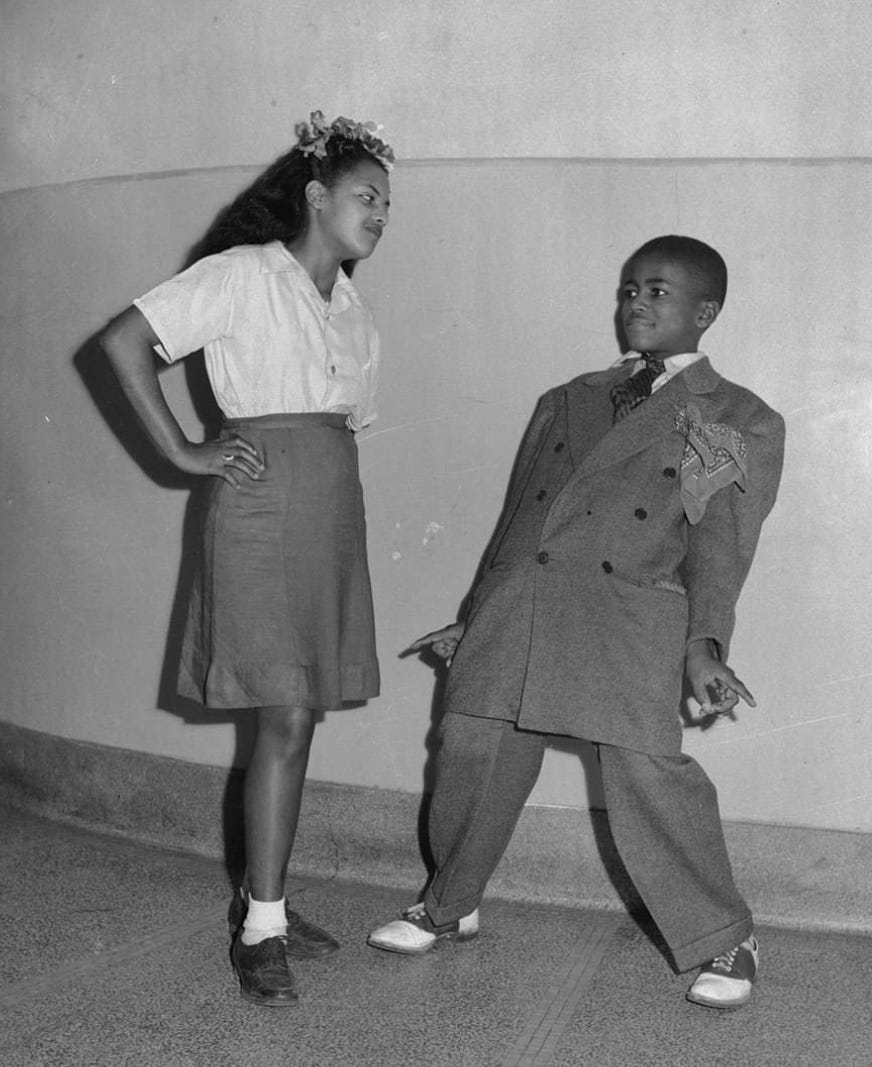
The profound effects of this era and style reflected in movies, music, cartoons, political ideas, books and so much more. It created generations that keep a respect for this era, and keep on coming back to it with the 1990 Swing revival, for example and today I have an inkling that baggy is making a comeback. If you want baggy, go zoot because you simply don’t want to look like a “square”.
You can find the zoot suit in: Spike Lee’s Malcolm X movie, or American Me directed by Edward James Olmos where the beginning of the movie started with the Zoot Suit Riots, Daffy Duck rocking a zoot suit, or Tom & Jerry’s zoot suit or Janet Jackson - Alright music video hommage to Cab Calloway. Also Mick Jones from the Clash wore a purple zoot suit on stage during one of the band’s earliest U.S. television appearances in L.A. in 1980.
I still would love to attach a cocktail at the end of this because that was the initial goal of this entry. It was hard to find menus from jazz bars or restaurants from the 1940’s, I shied away from food because to find a fitting meal with the zoot suit proved tough. So instead I found the cocktail that shares a similar story to the zoot suit. I chose the Sazerac because the name sounds jazzy and it was also banned in 1912 due to the original recipe containing Absinth.
The Sazerac
The official drink of New Orleans. The Sazerac is served straight up with no ice, it’s a low ball slow sipper with its roots that go back to the mid-1800’s.
It was named after an imported type of cognac called Sazerac-de-Forge et Fils. The establishment that imported the cognac invented the Sazerac cocktail and as it changed proprietors, so did the recipe. The second proprietor, Alan Bird changed the name of the establishment to The Sazerac Coffee House. There he served the Sazerac with the imported cognac and Peychaud bitters made by the local Creole apothecarist named Antoine Amedie Peychaud. According to Louisiana State Legislature they claim Antoine Amedie Peychaud as the inventor of the Sazerac. Once again, the proprietor changed to Tom Handy around 1870 where around that time the main ingredient of cognac changed to the more local rye whiskey because of a pest epidemic in France. Finally when absinthe was banned in 1912 it was replaced with another locally produced liqueur, Herbsaint.
There are several different recipes, majority stick with the rye and some add both cognac and rye, some add the absinth to coat the glass and others stick to the local Herbsaint. Hard to choose but that is the beauty of the history. So I found one that declares it as Tom Handy’s version through David Wondrich’s - Imbibe (2008 James Beard Award winner.) I would like to add an attribution for this recipe to Monica C
1 sugar cube
1/3 oz (10ml) cool water
2 oz (60ml) Rye Whiskey — Sazerac Rye or Rittenhouse Rye Bottled in Bond
2 dashes Peychaud Bitters
2 dashes Absinthe (or Herbsaint)
1 twist of Lemon Peel
You will need two glasses, the first preferably Old Fashioned or a Gibraltar and the second as a mixing glass.
Choose your drinking glass and chill by adding ice, let that sit meanwhile you prepare the Sazerac. In the mixing glass, add the sugar cube with cool water and muddle to crush the cube until combined. Add the whiskey and bitters into the mixing glass, fill it with ice and stir it well for a good 30 seconds. In your chilled glass, take out the ice and coat with absinthe, give it a swirl to cover the inside of your glass and discard any excess. Strain the cooled down whiskey into your absinthe coated glass and garnish with a sexy lemon peel. Serve with a glass of cold water.
I hope you enjoyed this longwinded entry.
Sazerac-ly yours,
The Greasy Pen.

